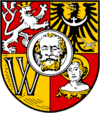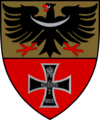Wroclaw coat of arms
The coat of arms of the city of Wroclaw is squared (quartered). It is in its present form in 1530 and became by Emperor Charles V confirmed.
description
The city's coat of arms is squared and has a silver bowl with the head of John the Baptist in the place of the central shield . In the first field there is a left-turning, crowned, double-tailed, silver lion on a red background. In the second field there is a black eagle with a silver crescent ( chest moon ) and a cross on its chest on a golden background . In the third field there is a black W on a golden background (from the Latin city name Wratislavia and the city's founder Wratislaw). In the fourth field there is the head of John the Evangelist with a golden halo (nimbus) on a red background . Below the neck, John the Evangelist wears a breast ornament in the form of an overturned crown.
meaning
The coat of arms in these squared shape with the head of John the Baptist in the middle of the city on 12 March 1530 by Ferdinand I awarded. John the Baptist is the patron saint of the Wroclaw Cathedral and the Diocese of Wroclaw . The silver lion represents the Bohemian lion . The black eagle represents the Silesian eagle . The black W stands for the Latin name of the city of Wroclaw: Wratislavia.
history
middle Ages
As early as 1360 , the coat of arms of the city of Breslau ("Civitas Wratislavi [ensis]") was depicted in the coat of arms hall of the Wenceslas Castle in Lauf an der Pegnitz . The squared coat of arms shows the head of John the Baptist in the first and fourth fields and the Bohemian lion in the second and third fields . The same coat of arms can also be found in the Wernigeroder coat of arms book from the 15th century (where Wroclaw is listed with the spelling "Stat Preslaw").
Coat of arms from 1530
The coat of arms was awarded by Ferdinand I on March 12, 1530 at the request of the city of Breslau . It was confirmed by Emperor Charles V on July 10, 1530 . In 1605 the coat of arms was shown in this form in Siebmacher's coat of arms book .
Coat of arms from 1938
During the time of National Socialism, the coat of arms with its Christian symbols such as John the Baptist and John the Evangelist was replaced by a new one. The coat of arms was designed by Hans Herbert Schweitzer (Mjölnir).
The coat of arms from 1938 was divided. In the upper field there was the black Silesian eagle on a golden background, but without a cross. In the lower field there was a black iron cross on a red background . On the top of the Iron Cross there was a crown, below it the inscription FW for the Prussian King Friedrich Wilhelm III. In the middle oak leaves and below the year 1813.
The Iron Cross was first donated in Breslau in 1813.
Coat of arms from 1948
In 1948, the Polish communist city administration introduced a new coat of arms referring to Poland. The coat of arms is split. In the front field was the white Polish eagle on a red background. In the back field the black Silesian eagle on a golden background. But without a cross and with a clover leaf and turned to the left.
Coat of arms from 1990
After the fall of communism, the city council of Wroclaw reintroduced the coat of arms in 1990, which was used from 1530 to 1938 and briefly from 1945 to 1948. It has been stylized and changed a little. In the new variant, John the Baptist turns his head to the right and instead of golden hair he has black hair.
The coat of arms in architecture
The Wroclaw coat of arms was also often used as decoration on building facades.
Coat of arms in Lauf Castle
Coat of arms on the town hall tower
Coat of arms on the former Elisabet-Gymnasium
Coat of arms on the Grunwald Bridge
literature
- "The coats of arms and seals of the German cities, towns and villages", Otto Hupp ( online )











